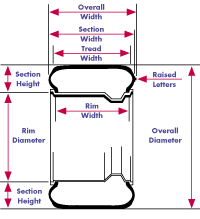Some examples:
P265/70R16: Width 265mm=10.43in, Height 265*70%=185.5mm = 7.3in
P225/75R15: Width 225mm=8.86in, Height 168.75mm = 6.64in
P205/65R15: Width 205mm=8.07in, Height 133.25mm = 5.25in
 Tire technical information
Tire technical informationHere is a link for Tire Tech information. The citation is below. Here is another useful tire calculator.
Section Width
Following the letter(s) that identify the type of vehicle and/or type of service for which the tire was designed, the three-digit numeric portion identifies the tire's "Section Width" (cross section) in millimeters.
P225/50R16 91S
The 225 indicates this tire is 225 millimeters across from the widest point of its outer sidewall to the widest point of its inner sidewall when mounted and measured on a specified width wheel. This measurement is also referred to as the tire's section width. Because many people think of measurements in inches, the 225mm can be converted to inches by dividing the section width in millimeters by 25.4 (the number of millimeters per inch).
225mm / 25.4 = 8.86"
Sidewall Aspect Ratio
Typically following the three digits identifying the tire's Section Width in millimeters is a two-digit number that identifies the tire's profile or aspect ratio.
P225/50R16 91S
The 50 indicates that this tire size's sidewall height (from rim to tread) is 50% of its section width. The measurement is the tire's section height, and also referred to as the tire's series, profile or aspect ratio. The higher the number, the taller the sidewall; the lower the number, the lower the sidewall. We know that this tire size's section width is 225mm and that its section height is 50% of 225mm. By converting the 225mm to inches (225 / 25.4 = 8.86") and multiplying it by 50% (.50) we confirm that this tire size results in a tire section height of 4.43". If this tire were a P225/70R16 size, our calculation would confirm that the size would result in a section height of 6.20", approximately a 1.8-inch taller sidewall.
Internal Construction
A letter (R in this case) that identifies the tire's internal construction follows the two digits used to identify the aspect ratio.
P225/50R16, P225/50ZR16
The R in the P225/50R16 91S size identifies that the tire has a Radial construction in which the tire's body plies "radiate" out from the imaginary center of the wheel. Radial tires are by far the most popular type of tire today representing over 98% of all tires sold.
If the R in the size was replaced with a D (225/50D16), it would identify that the internal tire body plies crisscross on a Diagonal and that the tire has a "bias ply" construction. Tires using this construction are for light truck and spare tire applications.
If the R in the size was replaced with a B (225/50B16), it would identify that the tire body plies not only crisscross the tire on a diagonal as before, but that they are reinforced with belts under the tread area. This type of tire construction is called "Belted." Tires using this construction are practically extinct.
Speed Rating
Today, the only tires that continue to include the speed rating "in" the tire size (P225/50ZR16) are Z-speed rated tires. In this case, following the two digits used to identify the aspect ratio are the letters ZR to identify the tire's speed rating (Z) and its internal construction (R). Since 1991, all other speed ratings are identified in the tire's Service Description (which will be covered shortly).
Tire and Wheel Diameter
P225/50R16 91S
The 16 indicates the tire and wheel diameter designed to be matched together.
Tires that have a rim diameter expressed in inches (P225/50R16, as well as 8, 10, 12, 13, 14, 15, 17, 18, 19, 20, 22, 23, 24, 26 and 28) are called "inch rim" sizes, are the most common type of tire size and are used on most cars, minivans, vans, sport utility vehicles and light duty light trucks.
While not as common, two additional "unique" types of tire/wheel diameters are still in use today.
Tires and wheels that have a rim diameter expressed in "half" inches (8.00R16.5LT, as well as, 14.5, 15.5, 17.5 and 19.5) are used on some heavy-duty trailers, heavy-duty light trucks and box vans.
Tires and wheels that have a rim diameter expressed in millimeters (190/65R390, as well as, 365 and 415) are called millimetric sizes. Michelin initiated millimetric sizes for their TRX tires that saw limited use on many different car models in the late 1970s and 1980s.
Michelin PAX System run flat tires have been introduced as an integrated wheel/tire system on a very limited basis as Original Equipment (O.E.) in North America. An example PAX System size of 235/710R460A 104T expresses tire and wheel dimensions in millimeters (235 mm Section Width, tire Overall Diameter of 710 mm and a 460A mm rim diameter, with the "A" in 460A signifying these tires feature "asymmetric" beads in which the outside bead (450 mm) and inside bead (470 mm) are actually different diameters.
All of these "unique" tire/wheel diameters were developed specifically because the tire and wheel design or intended vehicle use required them to be different than conventional tires and wheels. All of these tires and wheels feature bead profiles that have a different shape than traditional "inch rim" sizes.
Tires and wheels with unique rim diameters should never be combined with traditional "inch rim" tires and wheels.
It is critical that the tire and wheel diameters are always confirmed to match before the tire is mounted on the wheel.
Service Description
P225/50R16 91S
The 91S represents the tire's Service Description. A Service Description identifies the tire's Load Index and Speed Rating. Service Descriptions are required on all speed rated (except for Z-speed rated) tires manufactured since 1991. For more information on Service Descriptions, click here.

0 Comments:
Post a Comment
Subscribe to Post Comments [Atom]
<< Home